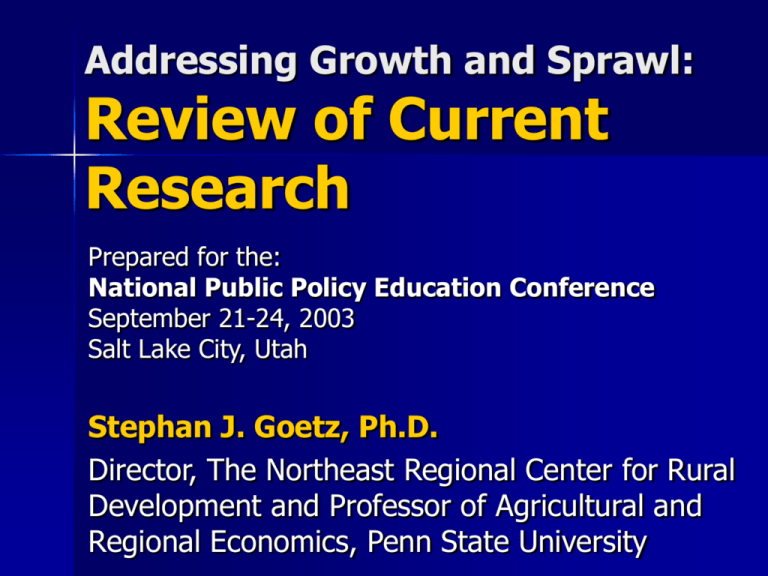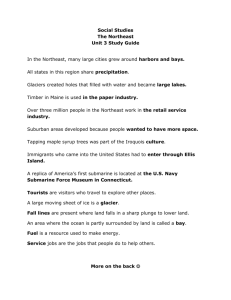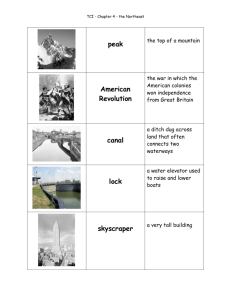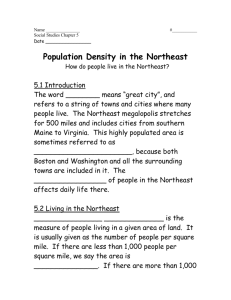Title Slide - Farm Foundation
advertisement

Addressing Growth and Sprawl: Review of Current Research Prepared for the: National Public Policy Education Conference September 21-24, 2003 Salt Lake City, Utah Stephan J. Goetz, Ph.D. Director, The Northeast Regional Center for Rural Development and Professor of Agricultural and Regional Economics, Penn State University Presentation Outline 1. 2. 3. Land Use Trends and Issues Determinants (consumer choices) Consequences (how do we draw attention to the issues?) 4. 5. Possible Solutions to Land Use Problems On-Going Research The Northeast Regional Center for Rural Development 1. Some Key Land Use Trends and Issues… Land on the urban fringe is cheaper, valued highly by homebuyers (a private benefit) Farmers sell land when the amount offered exceeds profits from agriculture plus nonpecuniary benefits (this raises many questions) Current residential development is widely perceived to have negative public impacts Major concern over irreversibility The Northeast Regional Center for Rural Development Developed Land: Top Ten States Rank 1 2 3 4 5 6 7 8 9 10 Acres of Developed Land in 1997 Texas California Florida Pennsylvania Georgia North Carolina Ohio Michigan New York Illinois Pct Non-Federal Land that was Developed Land in 1997 New Jersey Rhode Island Massachusetts Connecticut Puerto Rico Maryland Delaware Florida Pennsylvania Ohio Total Acres of Land Developed, 1992-97 Texas Georgia Florida California Pennsylvania North Carolina Tennessee Ohio Michigan South Carolina Source: Jill Schwartz, 2003, AFT Another key land use trend… Second or seasonal homes are an increasingly important rural land use In some areas long-time residents are being driven out by newcomers, as local property values escalate (gentrification) Trend driven by baby boomers, who are retiring into non-traditional areas? Accelerating since 9/11 and stock market retraction? The Northeast Regional Center for Rural Development The Northeast Regional Center for Rural Development 2. Determinants or drivers of current land use patterns… • Household/population numbers, growing incomes • Changing tastes and preferences (open space) • Societal trends (single-person households) • Technological change • Farm profitability, niche markets • Urban decay • Community planning (lack thereof) • Federal, state and local laws; home rule The Northeast Regional Center for Rural Development Determinants of new home construction, 1990-2002 Population growth* Falling HH size* Direct sales/farm* Income growth* Farm profits Gov. payments Pop. Density* -0.2 0 0.2 0.4 0.6 0.8 Bars show standardized estimates from a linear regression equation. Northeast US counties only. *Statistically different from zero The Northeast Regional Center for Rural Development 3. Consequences of current land uses/lifestyle choices (hypotheses) Growing traffic congestion Population health Environmental effects Social and economic effects Housing values The Northeast Regional Center for Rural Development 3750 Mobility Data for Washington DC-MD-VA, 1982-2000 700 3700 600 3600 Population Density Density 500 3550 400 3500 3450 300 3400 200 3350 Congestion Cost 3300 100 3250 3200 0 1982 1983 1984 1985 1986 1987 1988 1989 1990 1991 1992 1993 1994 1995 1996 1997 1998 1999 2000 Congestion Cost per Capita 3650 Possible health consequences of current land use patterns • Increasing levels of pollution (EPA) – suspended particles (soot) • Growing incidence of asthma in small children • Atlanta Olympics – natural experiment • Cancer risk rate map • Growing incidence of obesity, diabetes The Northeast Regional Center for Rural Development Reduction in selected variables during the 1996 Olympics, Atlanta, GA, in percent Traffic reduction -25 Peak ozone levels Asthma emergencies -50 -29 -43 -40 -30 Source: Friedman et al., 2001 (CDC/JAMA) -20 -10 0 Impact of residential choice on mode of transport of school children Percent of school age children walking to school as a function of distance between home and school 1 mile or less 1-2 miles 0 10 20 30 40 Impact of residential choice on weight (obesity) Residents of “most sprawling” community weigh 6.3 lbs more than residents of Manhattan, NY (the most dense or least-sprawling place); Reid Ewing Economic impacts of agriculture (as a type of land use) Underestimated? Source: The Northeast Center/E. Tavernier, 2002 State Agriculture Sector Multipliers EmployValue ment Output Added CT 1.49 1.52 1.24 NJ 1.52 1.58 1.25 NY 1.57 1.99 1.33 PA 1.75 2.34 1.46 How land use affects housing values R. Ready and C. Abdalla, Berks County,PA Study (funded by The Northeast Center), June 2003 – Examines impacts of alternative land uses on housing values (incl. open space) Elena Irwin, Land Economics, Nov. 2002 – Permanent preservation of open space yields a premium on home values …but, is housing development also economic development? Do counties that issue building permits at faster rates relative to the existing stock of homes also experience faster per capita income growth over time? The Northeast Regional Center for Rural Development Per Capita Income Growth vs. Building Permit Rate (1990-1999): All Northeast Counties 80% New York, NY Income Growth 70% 60% 50% 40% Calvert, MD 30% 20% 0% 10% 20% 30% 40% 50% 60% Permit Rate The Northeast Regional Center for Rural Development Per Capita Income Growth vs. Building Permit Rate: Suburbs (Non-Metro Adjacent Counties) 70% St. Mary's, MD Income Growth 60% 50% 40% 30% 20% 0% 5% 10% 15% 20% 25% 30% 35% Permit Rate The Northeast Regional Center for Rural Development Per Capita Income Growth vs. Building Permit Rate: Remote Rural Counties (non-metro nonadjacent) 70% Potter, PA Income Growth 60% 50% Nantucket, MA 40% 30% 20% 0% 5% 10% 15% 20% 25% 30% 35% Permit Rate The Northeast Regional Center for Rural Development 4. Possible “solutions” to sprawl Outlaw sprawl; enforce “smart growth” Use European model of property rights Raise gas taxes, stop new highway construction Eliminate home rule Use incentive payments and/or regulations Multi-functionality: Make green payments …in practice, the first four options may not be feasible The Northeast Regional Center for Rural Development 5. On-Going Research Determinants of new home construction (nation-wide) Second home locations and their impacts Trade, land use and the environment workshop (2004) The future viability of agriculture What are Society’s Objectives for How Land is Used? – Protect acres of farmland, food supply? – Protect farm families? – Provide rural employment? – Provide environmental benefits, scenic vistas? – Maintain/improve health of the population? – Encourage/support home ownership? Confusion abounds with regard to … what, where, and how to save or to use land resources. Paul W. Barkley What are homebuyers’ residential preferences and how do they compare with actual residential choices available? What is driving suburbanization? – Search for better schools? – Desire for green space? – Low-maintenance, newer, bigger homes? – Urban decay, crime, poverty? – Desire to drive more (SUVs)? What are the full benefits and costs of alternative patterns of development? Who benefits, who loses from land preservation programs? Which public policy objectives can be met by different portfolios of land use policies? Summary Determinants of Land Use Households Preferences Incomes Numbers Technological change Niche markets Farm profitability Economic vitality Urban decay Federal subsidies Institutions/laws Geography Other Benefits and Costs of Alternative Patterns of Development Pattern of Development Fiscal Impacts 1 Environmental Consequences (air, land, water) Ecosystem Impacts 2 3 4 Changing Land Use Traffic Patterns/ Congestion 6 Health Impacts Social Impacts 7 8 9 Economic Impacts (consumer well-being) Data sets Determinants and Impacts of Alternative Land Uses The Northeast Regional Center for Rural Development Other Resources from The Northeast Center Land Use Annual Research Workshop Proceedings – 2001: Orlando, Fl – 2002: Camp Hill, PA – 2003: Manchester, NH Special Issue of Agricultural and Resource Economics Review (April 2003)






